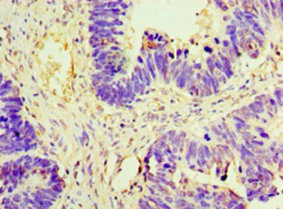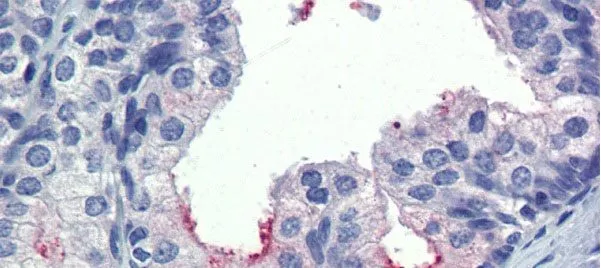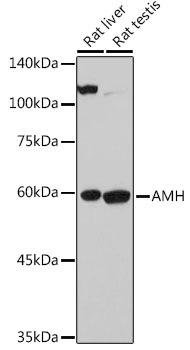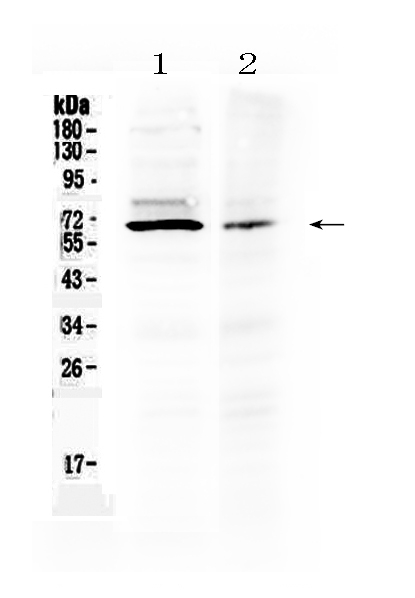![IHC-P analysis of ovarian tissue section from a 25 day old mouse using GTX42794 AMH antibody [5/6]. IHC-P analysis of ovarian tissue section from a 25 day old mouse using GTX42794 AMH antibody [5/6].](https://www.genetex.com/upload/website/prouct_img/normal/GTX42794/GTX42794_80_IHC-P_w_23060820_973.webp)
IHC-P analysis of ovarian tissue section from a 25 day old mouse using GTX42794 AMH antibody [5/6].
AMH antibody [5/6]
GTX42794
ApplicationsWestern Blot, ImmunoHistoChemistry, ImmunoHistoChemistry Paraffin
Product group Antibodies
TargetAMH
Overview
- SupplierGeneTex
- Product NameAMH antibody [5/6]
- Delivery Days Customer9
- Application Supplier NoteIHC-P: 1/20-1/40. *Optimal dilutions/concentrations should be determined by the researcher.Not tested in other applications.
- ApplicationsWestern Blot, ImmunoHistoChemistry, ImmunoHistoChemistry Paraffin
- CertificationResearch Use Only
- ClonalityMonoclonal
- Clone ID5/6
- ConjugateUnconjugated
- Gene ID268
- Target nameAMH
- Target descriptionanti-Mullerian hormone
- Target synonymsMIF, MIS, muellerian-inhibiting factor, Mullerian inhibiting factor, Mullerian inhibiting substance, anti-Muellerian hormone, muellerian-inhibiting substance
- HostMouse
- IsotypeIgG1
- Protein IDP03971
- Protein NameMuellerian-inhibiting factor
- Scientific DescriptionThis gene encodes a secreted ligand of the TGF-beta (transforming growth factor-beta) superfamily of proteins. Ligands of this family bind various TGF-beta receptors leading to recruitment and activation of SMAD family transcription factors that regulate gene expression. The encoded preproprotein is proteolytically processed to generate N- and C-terminal cleavage products that homodimerize and associate to form a biologically active noncovalent complex. This complex binds to the anti-Mullerian hormone receptor type 2 and causes the regression of Mullerian ducts in the male embryo that would otherwise differentiate into the uterus and fallopian tubes. This protein also plays a role in Leydig cell differentiation and function and follicular development in adult females. Mutations in this gene result in persistent Mullerian duct syndrome. [provided by RefSeq, Jul 2016]
- Storage Instruction-20°C or -80°C,2°C to 8°C
- UNSPSC12352203
References
- Barret JM, Nicolas A, Jarry A, et al. The Expression of Anti-Müllerian Hormone Type II Receptor (AMHRII) in Non-Gynecological Solid Tumors Offers Potential for Broad Therapeutic Intervention in Cancer. Biology (Basel). 2021,10(4). doi: 10.3390/biology10040305Read this paper
- Ozcan P, Takmaz T, Tok OE, et al. The protective effect of platelet-rich plasma administrated on ovarian function in female rats with Cy-induced ovarian damage. J Assist Reprod Genet. 2020,37(4):865-873. doi: 10.1007/s10815-020-01689-7Read this paper
- Özcan P, Fıçıcıoğlu C, Yıldırım ÖK, et al. Protective effect of resveratrol against oxidative damage to ovarian reserve in female Sprague-Dawley rats. Reprod Biomed Online. 2015,31(3):404-10. doi: 10.1016/j.rbmo.2015.06.007Read this paper







![IHC-P analysis of ovarian tissue section from a 25 day old mouse using GTX42793 AMH antibody [5/6].](https://www.genetex.com/upload/website/prouct_img/normal/GTX42793/GTX42793_79_IHC-P_w_23060820_192.webp)